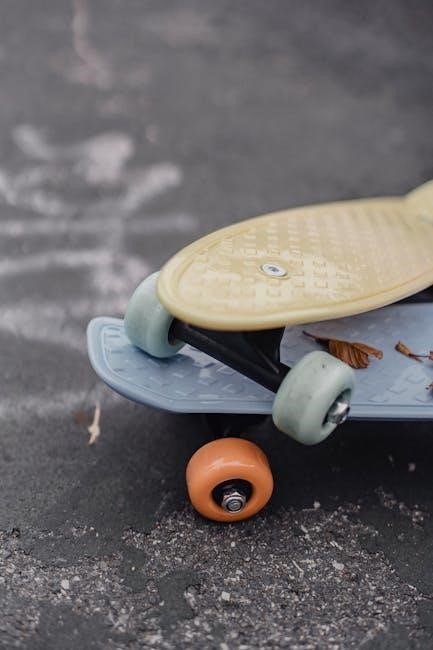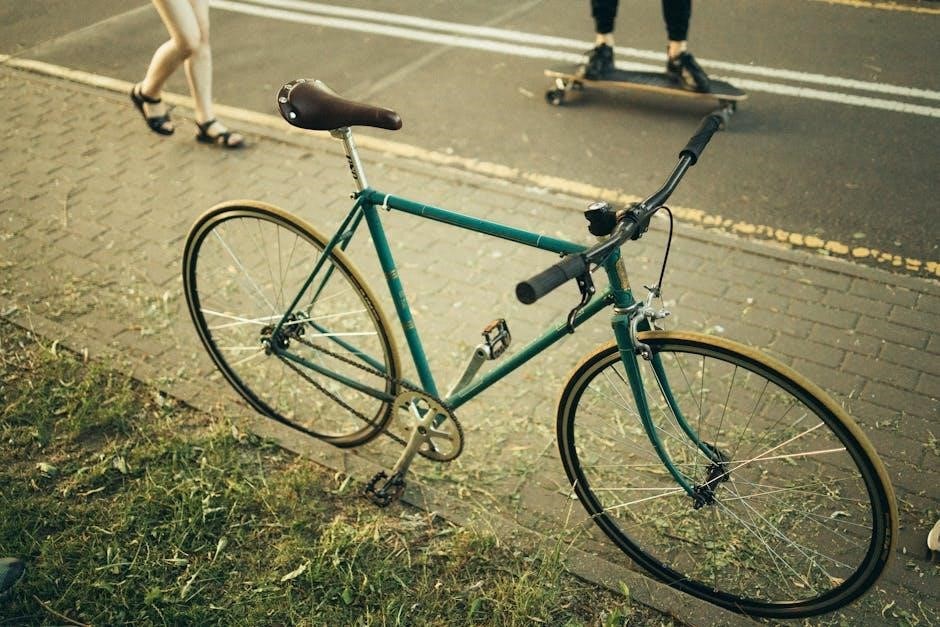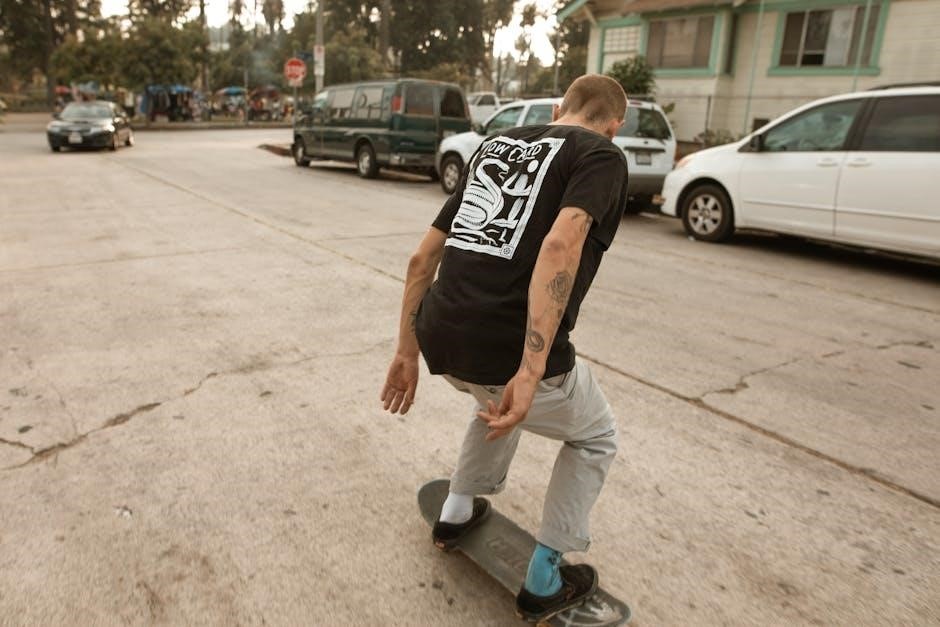Skateboard wheels are a crucial component, impacting speed, stability, and maneuverability. This guide helps you understand their importance and choose the best wheels for your skating style and preferences.
Why Skateboard Wheels Matter
Skateboard wheels play a pivotal role in determining your skating experience. They directly impact speed, control, and overall performance. The right wheels ensure stability, responsiveness, and compatibility with your skating style, whether cruising, street skating, or tackling rough terrain. Wheels also influence how well you can handle transitions and absorb shocks, making them essential for both beginners and experienced skaters. Choosing the wrong size or hardness can lead to a less enjoyable ride, while the right setup enhances maneuverability and confidence. Thus, understanding and selecting appropriate wheels is crucial for optimizing your skateboard’s performance and personal skating experience.
Understanding Skateboard Wheel Basics
Understanding skateboard wheel basics involves knowing their size, hardness, shape, and material. These factors collectively impact performance, stability, and the overall skating experience.
Wheel Size and Its Impact
Skateboard wheel size, measured in millimeters, significantly impacts performance. Smaller wheels (50-54mm) are ideal for street skating and tricks, offering agility and responsiveness. Medium wheels (55-59mm) provide a balance between speed and control, suitable for versatile skating. Larger wheels (60mm and above) excel on rough terrain and transitions, offering speed and stability. The size affects how easily you can navigate obstacles, ride over rough surfaces, and perform maneuvers. Choosing the right size ensures optimal performance for your skating style, whether you’re cruising, carving, or hitting the skatepark. Wheel size directly influences your board’s responsiveness and overall skating experience.
Wheel Hardness (Durometer Scale)
Wheel hardness is measured using the durometer scale, which determines how soft or hard the wheels are. Softer wheels (lower durometer ratings, e.g., 78A) provide better grip and are ideal for rough surfaces and cruising. Harder wheels (higher ratings, e.g., 95A-101A) are faster, more durable, and better for tricks and smooth surfaces.
The durometer scale is crucial for performance, as it affects grip, speed, and longevity. Softer wheels absorb shocks and stick to the ground, while harder wheels slide more easily and maintain speed. Choosing the right hardness ensures your wheels match your skating style and terrain preferences, enhancing your overall experience.

Wheel Shape and Its Effects
Wheel shape significantly impacts performance, with different shapes catering to specific skating styles. Round wheels offer smooth transitions, better speed, and easier slides, making them ideal for transition skating. Squarer shapes provide more grip and stability, suitable for street skating and quick turns. The shape affects how wheels make contact with the ground, influencing control and maneuverability. Softer, rounded lips enhance grip, while harder, squarer lips improve durability. The right shape ensures optimal performance for your preferred skating style, whether cruising, trick skating, or navigating rough terrain. Understanding wheel shape helps you choose wheels that align with your skating needs and preferences for a better experience.
Wheel Material and Durability
Skateboard wheels are typically made from polyurethane, a durable material known for its resistance to abrasion and ability to absorb shocks. The quality of the polyurethane greatly impacts the wheel’s performance and longevity. High-quality wheels are less likely to deform under stress and offer a smoother ride. Durability also depends on the wheel’s hardness, with softer wheels (lower durometer) wearing down faster but providing better grip. Larger wheels tend to be more durable but heavier, while smaller wheels are lighter but may wear more quickly. Proper maintenance, such as cleaning and avoiding extreme temperatures, can extend the life of your wheels. Investing in reputable brands ensures higher-quality materials and manufacturing processes, leading to more durable wheels that meet your skating needs.
Factors Influencing Wheel Choice
Skating style, terrain type, skill level, and personal preference are key factors in choosing skateboard wheels. Each influences the ideal size, hardness, and shape for optimal performance.
Skating Style and Wheel Selection
Different skating styles require specific wheel characteristics. Street skaters often prefer smaller, harder wheels for tricks and durability, while cruiser skaters opt for larger, softer wheels for smooth rides. Longboarders favor even larger wheels for speed and stability. Wheel size, hardness, and shape must align with the skater’s primary activities to ensure optimal performance and enjoyment. Understanding your skating style is the first step to selecting the right wheels, as it directly impacts how you interact with the board and the terrain. This alignment ensures a better skating experience tailored to individual needs and preferences.
Terrain Types and Wheel Suitability
The type of terrain you skate on significantly influences your wheel choice. Rough surfaces, such as cracked sidewalks or uneven streets, require larger, softer wheels for better grip and shock absorption. Smaller, harder wheels are ideal for smooth surfaces like skate parks or indoor facilities, offering faster speeds and sharper turns. For all-terrain skating, a medium-sized wheel with balanced hardness provides versatility. Understanding the terrain helps skaters select wheels that enhance performance, comfort, and control. Whether cruising, carving, or performing tricks, the right wheels ensure a smooth and enjoyable ride across various landscapes.
Skill Level and Wheel Appropriateness
Your skill level plays a significant role in selecting the right skateboard wheels. Beginners often benefit from softer wheels (lower durometer) as they provide better grip and cushioning, making it easier to balance and control the board. Softer wheels are more forgiving on rough landings, reducing the risk of slipping. For advanced skaters, harder wheels (higher durometer) are ideal, offering faster speeds and sharper turns. Intermediate riders may prefer medium-hardness wheels, which balance speed and stability. Matching your skill level to the appropriate wheel hardness ensures a smoother learning curve and enhances overall performance. Proper wheel choice can make a noticeable difference in how confidently and effectively you skate.
Personal Preference in Wheels

Personal preference significantly influences skateboard wheel choice, as skaters prioritize different features based on their unique needs and skating experiences. Some riders prefer softer wheels for better grip and comfort, while others opt for harder wheels for speed and precision. The shape of the wheel can also be a matter of preference, with rounded lips offering easier slides and square lips providing stability. Additionally, personal style, such as cruising, street skating, or park skating, shapes preferences for size, hardness, and durability. Ultimately, the right wheels are those that align with how you skate and what feels most comfortable and enjoyable to you.

How to Choose the Right Skateboard Wheels
Assess your skating style, terrain, and skill level to select wheels that match your needs. Consider size, hardness, and shape to ensure optimal performance and comfort.

Choosing the Right Wheel Size
Wheel size significantly impacts your skateboarding experience. Smaller wheels (50-54mm) are ideal for street skating, offering quick acceleration and tight maneuverability. Larger wheels (55-60mm) suit rough terrain and transitions, providing stability and smoother rides. For cruising, 60mm+ wheels are best, ensuring speed and comfort on flat surfaces. Consider your skating style and preferred terrain to select the optimal size. Test different sizes if possible to find your preference for performance and control.
Selecting the Appropriate Hardness
Wheel hardness, measured on the durometer scale, plays a key role in performance. Softer wheels (78A-87A) provide better grip and cushioning, ideal for rough terrain and cruising. Harder wheels (95A-101A) offer speed, durability, and slide control, perfect for street skating. Medium hardness (88A-94A) balances both, making them versatile for various styles. Consider your skating style, terrain, and personal preference when choosing hardness. Softer wheels are great for beginners seeking stability, while harder wheels suit experienced skaters prioritizing speed and control. Always match your wheel hardness to your skating environment for optimal performance and comfort. Proper hardness ensures a smooth ride and enhances your overall skating experience.
Picking the Ideal Wheel Shape
Wheel shape significantly impacts performance, with rounded, square, or angled edges offering distinct skating experiences. Rounded edges provide better grip and smoother transitions, ideal for bowls and vert skating. Square edges enhance stability and control, making them perfect for technical street skating. Angled wheels combine both, offering versatility for various styles. The shape affects how wheels interact with the ground, influencing speed, maneuverability, and slide characteristics. Consider your skating style and terrain when selecting a shape. For example, rounded wheels excel in rough surfaces, while square wheels are better for precise tricks. Choosing the right shape ensures optimal performance and enhances your skating experience. Proper fit is key to achieving desired results.
Considering the Brand and Quality
When selecting skateboard wheels, it’s essential to consider the brand and quality to ensure durability and performance. Reputable brands use high-quality materials and precise manufacturing processes, resulting in consistent and reliable wheels. Cheaper alternatives may compromise on material quality, leading to faster wear and poor performance. Look for brands known for their commitment to innovation and durability. Higher-quality wheels often feature advanced formulas that enhance grip, speed, and longevity. Investing in a reputable brand ensures better skating experiences and extends the life of your wheels. Always research and read reviews to find the best brand for your specific skating style and needs;

Maintenance and Care of Skateboard Wheels
Regular cleaning and inspections are vital to extend the life of your skateboard wheels. Remove dirt and debris to maintain grip and performance, ensuring smooth rides.
Tips for Maintaining Your Wheels
Regular maintenance is essential to keep your skateboard wheels in optimal condition. Start by cleaning your wheels thoroughly with a soft cloth and mild soap to remove dirt and grime that can hinder performance. Avoid using harsh chemicals that might damage the wheel material. Next, inspect your wheels for wear and tear. If you notice uneven wear or significant damage, it may be time to rotate or replace them. Rotating your wheels periodically can help ensure even wear and extend their lifespan. Additionally, lubricate the bearings inside your wheels to keep them spinning smoothly. Use a high-quality bearing lubricant and apply it sparingly to avoid attracting more dirt. Tighten your wheels appropriately—too loose can cause instability, while too tight can strain the bearings. Store your skateboard in a dry, cool place to prevent rust and damage. Finally, check and maintain your wheels regularly to ensure they remain in good condition for a better skating experience.

Signs It’s Time to Replace Your Wheels
If your skateboard wheels show visible wear, such as uneven edges or significant reduction in size, it’s time to replace them. Cracks or deep scratches on the surface indicate structural weakening. If your wheels feel brittle or break easily, they’ve likely reached the end of their lifespan. Additionally, if your board vibrates excessively or wobbles during rides, worn-out wheels may be the cause. Faded or discolored wheels can also signal aging material. Replacing them ensures safety, stability, and optimal performance. Don’t wait until a wheel fails completely, as it can lead to accidents. Regular inspections can help you identify when replacement is necessary.


